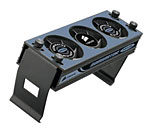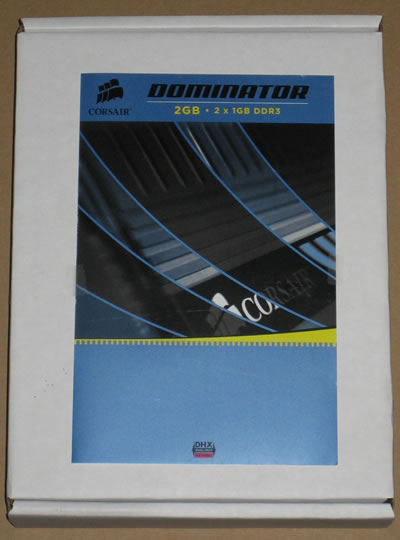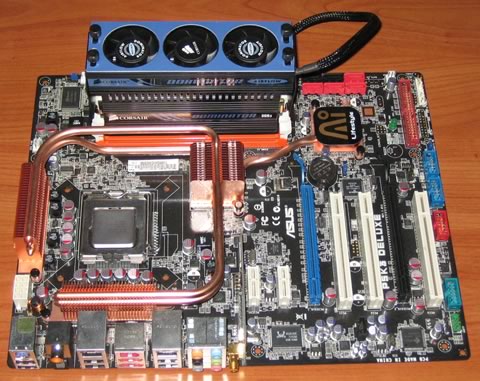1. Features, installation
 Corsair
as a well known and respected memory manufacturer that recently
released a new series of DDR3 memory with the highest rated
specification and a very low CAS latency. The new TWIN3X2048-1800C7DF
G product promises ultimate performance and high overclocking
margins. Let's find out what this memory is capable of when paired with
an Asus P5K3 Deluxe WiFi Edition motherboard.
Corsair
as a well known and respected memory manufacturer that recently
released a new series of DDR3 memory with the highest rated
specification and a very low CAS latency. The new TWIN3X2048-1800C7DF
G product promises ultimate performance and high overclocking
margins. Let's find out what this memory is capable of when paired with
an Asus P5K3 Deluxe WiFi Edition motherboard.
- Corsair TWIN3X2048-1800C7DF G
The Dominator Series TWIN3X2048-1800C7DF G is a 2048 MB kit of DDR3
SDRAM DIMMs built using Corsair’s latest high performance heat sink
with Dual-path Heat Xchange (DHX) technology coupled with a Corsair
Airflow Fan. This part delivers outstanding performance in the latest
generation of dual-channel DDR3-based motherboards. It has been tested
extensively in popular DDR3 motherboards to ensure compatibility and
performance at its rated speed. This memory has been verified to
operate at 1800MHz at latencies of 7-7-7-20 at 2.0V VDIMM.

The DOMINATOR family of memory represents the ultimate in
performance technology engineering from Corsair. The Dominator
was designed to have the highest performing IC maximum
overclocking capability and efficient DHX cooling – all the while being
stable and reliable.
Heat Dissipation
Heat is the enemy of your computer’s key components. And the more
you tweak components for performance, the more heat is generated.
Heat will slow down your system and impact long term reliability. With
traditional DDR2 memory, the standard method of chip packaging
involves a BGA (Ball Grid Array). In a BGA, small balls of solder,
organized as a grid, are the leads that connect the device to the
module circuit board. A Micron Semiconductor study shows that in a
BGA memory device as much as 50% of the heat generated by the chip
is actually conducted into the circuit board. Since traditional heat sinks
are only attached to the front surface of memory chips, there’s no easy
thermal path for the heat coming from the back of the chips.
DHX - Maximized Performance, Minimized Heat
Corsair’s engineers have developed a unique technology that
maximizes heat dissipation while improving reliability, even in the most
extremely overclocked memory module. Dual-Path Heat Exchange
(DHX) technology utilizes two methods to effectively remove heat
from the memory circuit board - Convection and Conduction.
 Optional AirFlow - Extra Cooling for Extreme Overclocking
Optional AirFlow - Extra Cooling for Extreme Overclocking
The optional Airflow fan unit contains three 40mm tachometer-controlled
fans to provide impinging airflow to the memory subsystem. With the
moderate RPMs required to provide adequate forced air, the Airflow fan is
nearly silent. The fan easily clamps onto most motherboards.
- Main features
- 2048 Megabytes of DDR3 memory
- Two matched CM3X1024-1800C7D G
modules
- Using DHX technology providing maximum
cooling
- Comes with Airflow Fan for maximum thermal
transfer
- 100% tested at 1800MHz in high performance
DDR3 motherboards
- Lifetime warranty
- Module Size: 2GB kit (1GBx2)
- Each module pair is tested together at 1800MHz
- Tested together at 1800MHz, Vdimm = 2.0V,
at latency settings of 7-7-7-20 on ASUS P5K3
motherboards
- Must use sockets DIMM A2 and DIMM B2
(”black sockets”) to achieve this performance
- SPD programmed at: JEDEC standard 9-9-9-24 values at
1333MHz
- Retail package
Corsair provided us the retail package of TWIN3X2048-1800C7DF G. The retail price of the package is around $540~781, depending your location and currency... The memory modules are carefully packaged inside a common carton box.

with several protecting foam sheets

Finally, we can see the DDR3 memory modules, in right inside the white box we can find the optional memory cooler.

Removing the memory modules from the retail box, we can have a
clearer view. From front, there's the Corsair logo along with all
the important specifications, the memory size, the DDR3 rating speed
and of course CAS latencies and suggested memory voltage. The black
aluminium heatsinks on the outside are designed to absorb the heat from
the surface of the memory modules:

At the back, there are two logos,

The Corsair Dominator Airflow can be installed in all DDR2/DDR3
memory types and uses three almost noiseless 40mm fans to improve
heat dissipation.



Here is how our test system looks like after the installation
of both Corsair Dominator DDR3 memory modules and the
optional cooler:

After installing the modules and using CPU-Z v1.41 we have more
information about the memory. Corsair is probably the first
manufacturer that supports Intel's XMP profiles for 1800 rating speed.
Of course there are present the standard JEDEC timings embedded
for 592 and 666MHz accordingly:

Extreme Memory Profile (XMP) technology comes from Intel. Extreme
memory profiles (XMP) are SPD (Serial Presence Detect) settings that
are activated once memory modules are installed into a system with a
mainboard that supports such settings. It is projected that XMP will be
supported by mainboards based on Intel X38 chipset and will allow
memory modules to operate at higher clock speeds with aggressive
latency settings in order to provide extra performance.